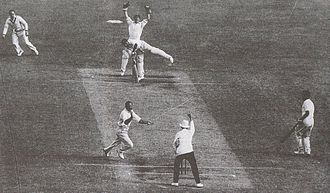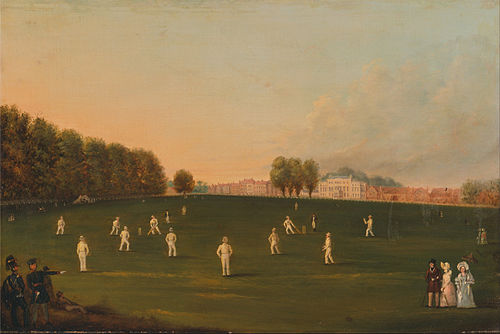History of International Cricket
Cricket, a sport with its origins in south-east England, has a well-documented history that traces back to the late 16th century. It gained significant popularity and became an established sport in the 18th century, eventually expanding its reach globally during the 19th and 20th centuries. International cricket matches have been a part of the sporting landscape since the 19th century, with formal Test cricket matches recognized as originating in 1877. While cricket holds the distinction of being the world’s second most popular spectator sport, following association football (soccer), it is worth noting that only twelve nations currently participate in Test cricket out of the International Cricket Council’s (ICC) extensive membership of over one hundred countries and territories.
The Laws of cricket serve as the definitive guide to the game’s rules. Cricket offers a diverse range of formats, catering to different preferences and time constraints. One-day cricket and T20 cricket, for instance, is played over a few hours, providing a shorter and more condensed version of the game. On the other hand, Test cricket are known for their extended duration, often lasting up to five days, allowing for a comprehensive examination of skills and strategies on the field.
INTERNATIONAL CRICKET EXPANSION BEYOND ENGLAND
International Cricket’s expansion extended well beyond its origins in England. The sport made its way to North America during the 17th century through English colonies, potentially even before it reached the northern regions of England. Throughout the 18th century, cricket found its footing in various parts of the world. Colonists introduced it to the West Indies, while mariners of the East India Company brought the game to the Indian subcontinent in the first half of the century. With the onset of colonization in 1788, cricket quickly took hold in Australia. New Zealand and South Africa followed suit in the early 19th century, embracing the sport as well.
However, cricket failed to gain traction in Canada despite the upper class’s attempts to promote it as a means of aligning with the “mother country.” Unlike Australia and the West Indies, Canada experienced a steady decline in cricket’s popularity from 1860 to 1960. Due to its association with an elite sport in the public’s perception, it failed to resonate with the general population. Additionally, cricket had to compete with baseball during the summer season, further limiting its appeal. During the First World War, Canadian units stationed in France opted to play baseball instead of cricket, cementing the decline of the sport in Canada during that period.
HISTORY OF CRICKET LAWS
The exact origins of the fundamental rules of cricket, encompassing elements like bat and ball, wickets, pitch dimensions, overs, and methods of dismissal, remain unclear. However, in 1728, the Duke of Richmond and Alan Brodick established Articles of Agreement to outline the guidelines for a specific game. This practice became common, particularly in relation to matters such as the distribution of stake money and winnings, owing to the significant role of gambling in the sport.
In 1744, the Laws of Cricket were first codified, with subsequent amendments made in 1774 to incorporate innovations like lbw (leg before wicket), middle stump, and maximum bat width. These laws stipulated that “the principals shall choose from amongst the gentlemen present two umpires who shall absolutely decide all disputes.” The “Star and Garter Club” formulated these codes and its members later founded the Marylebone Cricket Club (MCC) at Lord’s in 1787. The MCC took on the responsibility of preserving the Laws and has since carried out periodic revisions and recodifications to ensure their relevance.
EXPANSION OF INTERNATIONAL CRICKET

Cricket, originally a British sport, spread to various colonies across the world. In 1909, the Imperial Cricket Conference was established with England, Australia, and South Africa as its founding members. The conference included the Marylebone Cricket Club, the Australian Board of Control for International Cricket, and the South African Cricket Association as the original associations of the ICC. Its primary objective was to regulate international cricket among these three nations, which were considered to be of equal status at the time. In 1926, New Zealand and the West Indies were admitted as members, allowing them to participate in Test cricket against the other nations. However, cricket in the West Indies was predominantly dominated by the white population during that period. Initially, the ICC showed little interest in expanding the global popularity of cricket and was reluctant to invite non-Commonwealth countries to play. New Zealand was restricted to three-day Test matches, and it was only after World War II that both New Zealand and India became Test-playing nations, with Pakistan joining soon afterwards in 1952.
In 1965, following a proposal from Pakistan, the ICC expanded its membership to include non-Test playing countries, admitting them as Associate members. Concurrently, the organization changed its name to the International Cricket Conference. The first limited-overs World Cups were held in the 1970s, and Sri Lanka achieved the distinction of becoming the first Associate member to be promoted to Test playing status in 1982. However, since the ICC was primarily dominated by Western countries, the founding nations had the authority to determine who could join the conference or participate in Test cricket. There was no intention or effort to establish a group of Associate nations that could play at the Test level, which is why countries like Sri Lanka were not permitted to do so until the 1980s.
Over time, the international game continued to grow, and in 1984, the concept of Affiliate Member status was introduced, offering membership to teams with less cricketing history. In 1989, the ICC underwent a name change and became the International Cricket Council. Zimbabwe achieved Full Member status in 1992, followed by Bangladesh in 2000, thus expanding the number of Full Members to 10. Afghanistan and Ireland joined as Test-playing nations in 2018, bringing the total number of full members of the ICC to 12.
USE OF GRAPHIC AND ANALYTIC TECHNOLOGY IN CRICKET
The introduction of limited-overs cricket had a significant impact on television ratings for cricket coverage. The innovative techniques implemented in the coverage of these shorter-format matches were quickly adopted for Test match coverage as well. These advancements included the presentation of comprehensive statistics and graphical analysis, the placement of miniature cameras in the stumps to provide unique perspectives, the use of multiple cameras to capture shots from various angles around the ground, high-speed photography, and computer graphics technology that enabled viewers to closely analyze the trajectory of a delivery and better understand umpires’ decisions.
In 1992, the concept of a third umpire was introduced in Test cricket during the series between South Africa and India. The third umpire initially served to adjudicate run-out appeals by utilizing television replays. Over time, the responsibilities of the third umpire expanded to include decisions on other aspects of play, such as stumpings, catches, and boundaries. Starting in 2011, the third umpire also played a crucial role in moderating the review of umpires’ decisions, including lbw (leg before wicket), utilizing virtual-reality tracking technologies like Hawk-Eye and Hot Spot. However, despite the advancements in technology, some disputed decisions still sparked heated controversy, highlighting the inherent challenges of completely eliminating debate in cricket.
ONE DAY INTERNATIONAL CRICKET

A One Day International cricket (ODI) is a variant of limited overs cricket that involves two teams with international status. In this format, each team is allotted a fixed number of overs, currently set at 50, and the duration of the game can span up to 9 hours. The prestigious Cricket World Cup, typically held every four years, is contested in this format. One Day International matches are also referred to as Limited Overs Internationals (LOI), although the term “LOI” can also encompass Twenty20 International matches. These matches hold significant importance and are regarded as the pinnacle of List A limited-overs competition, showcasing the highest level of cricketing standards.
The international one-day game emerged as a significant development in the late twentieth century. The inaugural One Day International (ODI) took place on 5 January 1971 between Australia and England at the Melbourne Cricket Ground. Due to persistent rain that washed out the first three days of the third Test, officials decided to abandon the Test match and instead organize a one-off one-day game comprising 40 eight-ball overs per side. Australia emerged victorious in this encounter, winning by 5 wickets. During this period, ODIs were played with teams donning white-colored kits and using a red ball.
In the late 1970s, Kerry Packer established the rival World Series Cricket (WSC) competition, which introduced several features that have become commonplace in One Day International cricket. These innovations included the use of colored uniforms, matches played at night under floodlights with a white ball, dark sight screens, and enhanced television broadcasts featuring multiple camera angles, effects microphones capturing on-field player sounds, and on-screen graphics. The first match featuring colored uniforms occurred on 17 January 1979 at VFL Park in Melbourne, with the WSC Australians sporting wattle gold kits and the WSC West Indians dressed in coral pink. This groundbreaking development not only secured Channel 9, owned by Packer, the TV rights to cricket in Australia but also transformed players into international professionals who were remunerated for their participation, eliminating the need for alternative employment outside of cricket. As time progressed, matches played with colored kits and a white ball became more commonplace, ultimately leading to the abandonment of white flannels and red balls in ODIs in 2001.
The International Cricket Council (ICC), the governing body of international cricket, maintains the ICC ODI Rankings for teams, batsmen, bowlers, and all-rounders, providing a comprehensive assessment of performance in the ODI format.
T20 INTERNATIONAL CRICKET

Twenty20 (T20) International cricket is an abbreviated format of the game. The professional introduction of T20 cricket took place in 2003 by the England and Wales Cricket Board (ECB) for the inter-county competition. In this format, each team has a single innings, which is limited to a maximum of twenty overs. Alongside first-class and List A cricket, Twenty20 is recognized by the International Cricket Council (ICC) as one of the three premier forms of the game, played at the highest international and domestic levels.
A typical Twenty20 match can be completed in approximately two and a half hours, with each innings lasting around 70 minutes. There is an official 10-minute break between the innings. This duration is considerably shorter than previous versions of the game and aligns more closely with the time frame of other popular team sports. The intention behind the introduction of T20 cricket was to create an exciting and fast-paced game that would captivate spectators at the venue and engage viewers on television.
T20 cricket has successfully gained popularity worldwide. Most international tours now include at least one Twenty20 match, and all Test-playing nations have their own domestic cup competitions dedicated to this format. The game’s appeal and reach continue to expand, captivating cricket enthusiasts across different regions of the world.
In 2004, Pakistan hosted its inaugural Twenty20 competition, which saw participation from thirteen teams representing different regions of the country. The Faisalabad Wolves emerged as the first winners of the tournament. Australia’s first Twenty20 match took place on 12 January 2005 at the WACA Ground, featuring the Western Warriors and the Victorian Bushrangers. The match garnered significant attention, drawing a sell-out crowd of 20,000 spectators, marking the first sold-out match at the venue in nearly 25 years.
From 11 July 2006, the Stanford 20/20 tournament took place, featuring 19 regional teams from the West Indies. This event, financially supported by billionaire Allen Stanford, received a funding of at least US$28,000,000. The tournament was initially planned to be an annual affair. Guyana emerged as the winners of the inaugural event, defeating Trinidad and Tobago by five wickets and securing a prize money of US$1,000,000.
On 5 January 2007, an unexpected crowd of 16,000 fans turned up to watch the Twenty20 match between the Queensland Bulls and the New South Wales Blues at The Gabba in Brisbane. The overwhelming response caused the Gabba staff to open the gates and allow many fans free entry, ultimately attracting a total attendance of 27,653. In February 2008, a record-breaking crowd of 85,824 spectators attended the Twenty20 match between Australia and India at the Melbourne Cricket Ground. This high-profile match featured the reigning Twenty20 World Champions against the ODI World Champions.
The Stanford Super Series, held in October 2008, brought together three teams: Middlesex and Trinidad and Tobago, the respective winners of the English and Caribbean Twenty20 competitions, along with a team named Stanford Superstars comprising players from West Indies’ domestic circuit. Trinidad and Tobago emerged as the champions of the tournament, securing a prize money of US$280,000. On 1 November, the Stanford Superstars faced England in what was expected to be the first of five matches over the next five years, with each winner claiming a staggering US$20,000,000. Although the Stanford Superstars won the first match, subsequent fixtures were not held due to Allen Stanford being charged with fraud in 2009.


Following the widespread popularity of the 2007 ICC World Twenty20, several T20 leagues emerged on the cricketing scene. In 2008, the Board of Control for Cricket in India (BCCI) launched the Indian Premier League (IPL), which has since become the largest cricket league globally. The IPL adopts the North American sports franchise system and features ten teams based in major Indian cities. In September 2017, the broadcasting and digital rights for the next five years (2018–2022) of the IPL were sold to Star India for a staggering US$2.55 billion, solidifying its status as one of the most financially lucrative sports leagues in the world. The brand valuation of the IPL skyrocketed to US$5.3 billion after its tenth edition, as reported by global valuation and corporate finance advisor Duff & Phelps.
Following the IPL’s success, several other T20 leagues were established using similar formats, and they gained significant popularity among fans. The Big Bash League, Bangladesh Premier League, Pakistan Super League, Caribbean Premier League, and Afghanistan Premier League are notable examples of these leagues. Additionally, women’s cricket saw the creation of the Women’s Big Bash League by Cricket Australia in 2015, while the Kia Super League commenced in England and Wales in 2016. South Africa joined the T20 league wave with the introduction of the Mzansi Super League in 2018.
Many of these T20 leagues follow a general format, consisting of a group stage followed by a Page playoff system among the top four teams. The highest and second-highest placed teams from the group stage compete in a match, with the winner advancing to the final. The third and fourth-placed teams face off, with the losing team being eliminated. The remaining two teams, who have not yet secured a spot in the final, compete to determine the second finalist. In the Big Bash League, an additional match is played to determine which of the fourth or fifth-placed teams will qualify for the top four.
T20 INTERNATIONAL MATCHES
The inaugural Twenty20 International (T20I) match took place on 5 August 2004 between the women’s teams of England and New Zealand. New Zealand emerged victorious, winning by nine runs.
On 17 February 2005, Australia and New Zealand competed in the first men’s international T20I match at Eden Park in Auckland. The match was played in a light-hearted manner, with both teams donning kits reminiscent of the 1980s. The New Zealand team wore a direct replica of the attire worn by the Beige Brigade, a group of passionate cricket supporters. Some players even sported retro hairstyles, moustaches, and beards, participating in a friendly competition for the “best retro look” as requested by the Beige Brigade. Australia convincingly won the game, and as the result became evident towards the end of New Zealand’s innings, the players and umpires adopted a less serious approach. Glenn McGrath humorously reenacted the infamous Trevor Chappell underarm incident from a 1981 One Day International (ODI) between the two sides, prompting umpire Billy Bowden to jokingly show him a mock red card, despite red cards not being used in cricket.
The first T20I match in England was held on 13 June 2005 at the Rose Bowl in Hampshire, with England facing Australia. England secured a record victory, winning by a margin of 100 runs, a record that stood until 2007.
On 9 January 2006, Australia and South Africa competed in the first international T20I match in Australia. In a unique move, the players’ nicknames were displayed on the back of their uniforms instead of their surnames. The match, held at The Gabba, attracted a crowd of 38,894 spectators.
On 16 February 2006, New Zealand and the West Indies faced off in a tie-breaking bowl-out after the game ended in a tie with both teams scoring 126 runs. New Zealand emerged victorious in the bowl-out, winning 3-0. Notably, this match marked the last international appearance for cricketer Chris Cairns.
The International Cricket Council (ICC) has recognized T20 as the optimal format for globalizing the game. In 2018, the ICC announced that all T20 matches played between its member nations would be granted international status. This decision led to a significant increase in the number of T20I matches played worldwide, promoting the growth and global appeal of the format.
IMPACT OF T20 ON CRICKET GAME
Twenty20 cricket is often credited with introducing a more athletic and explosive style of play. According to Indian fitness coach Ramji Srinivasan, the format has raised the fitness bar for all players, demanding higher levels of strength, speed, agility, and reaction time regardless of their role in the team. Players like Matthew Hayden have acknowledged the positive impact of retirement from international cricket, which has allowed them to excel in terms of performance and fitness, particularly in tournaments like the Indian Premier League.
In June 2009, former Australian wicketkeeper Adam Gilchrist advocated for Twenty20 to be included as an Olympic sport, emphasizing its potential to spread the game globally in a quick and cost-effective manner. Many Associate members of the International Cricket Council (ICC) have embraced the T20 format due to its improved financial viability compared to other formats of the game.
However, not everyone has embraced Twenty20 without reservations. Former Australian captain Ricky Ponting has criticized the format, expressing concerns about its impact on Test cricket, particularly its potential to hinder batsmen’s scoring skills and concentration. Similar concerns have been voiced by former Australian captain Greg Chappell, who fears that excessive focus on T20 could impede the complete development of batting skills, while former England player Alex Tudor has expressed similar concerns regarding bowling skills.
Former West Indies captains, including Clive Lloyd, Michael Holding, and Garfield Sobers, have criticized Twenty20 for its role in discouraging players from representing their national test cricket sides. Many West Indies players, such as Chris Gayle, Sunil Narine, and Dwayne Bravo, have prioritized playing in Twenty20 franchise leagues worldwide, driven by the lucrative financial rewards on offer.
The opinions surrounding Twenty20 cricket are varied, with some praising its athletic intensity and potential for global growth, while others express concerns about its impact on traditional formats of the game and player development.
That’s all now from the cricket history.



